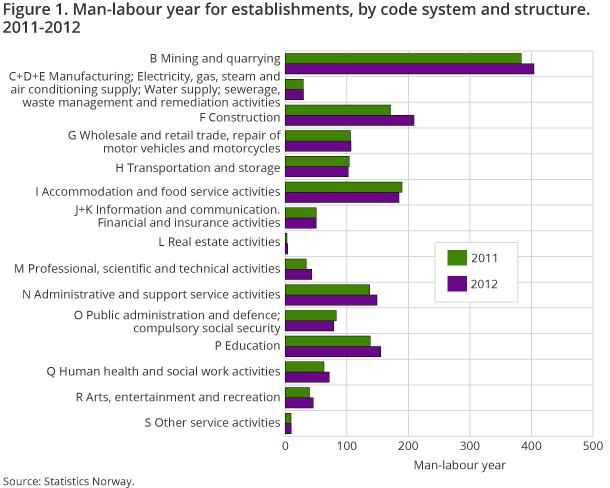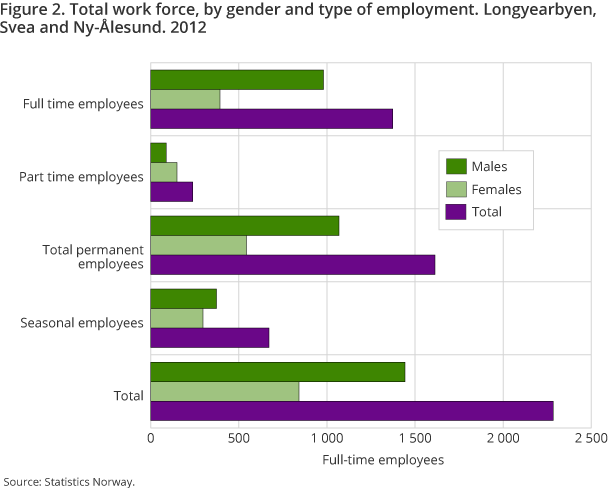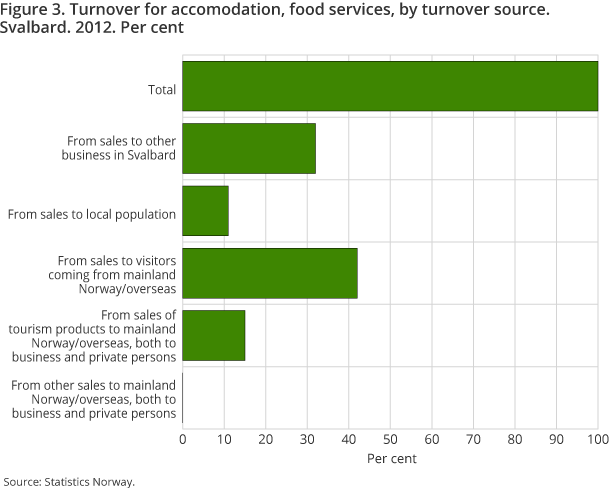Content
Published:
This is an archived release.
Turnover in Svalbard declined
Turnover for local KAUs operating in Svalbard declined by 7.5 per cent to NOK 3.2 billion from 2011 to 2012. Meanwhile, the number of FTEs rose 6.7 per cent to 1 642.
| Man-year | Turnover (NOK 1 000) | |||
|---|---|---|---|---|
| 2012 | Percentage change from last year | 2012 | Percentage change from last year | |
| Svalbard total | 1 642.2 | 6.7 | 3 205 884 | -7.6 |
| Mining and quarrying | 404.0 | 5.3 | 959 820 | -33.0 |
| Manufacturing; Electricity, gas, steam and air conditioning supply; Water supply; sewerage, waste management and remediation activities | 29.6 | 1.4 | : | : |
| Construction | 208.9 | 22.3 | 528 538 | 35.4 |
| Wholesale and retail trade: repair of motor vehicles and motorcycles | 106.5 | 0.8 | 388 155 | 11.7 |
| Transportation and storage | 102.2 | -1.4 | 257 476 | 0.9 |
| Accommodation and food service activities | 184.7 | -2.6 | 207 245 | -5.7 |
| Information and communication | 50.3 | 0.4 | 272 448 | 5.0 |
| Real estate activities | 3.8 | 46.2 | 73 192 | -4.7 |
| Professional, scientific and technical activities | 43.4 | 27.6 | 27 912 | 59.7 |
| Administrative and support service activities | 148.8 | 8.5 | 247 228 | -0.2 |
| Public administration and defence | 78.8 | -4.8 | 11 264 | -12.8 |
| Education | 154.9 | 12.2 | : | : |
| Human health and social work activities | 71.4 | 13.3 | 12 081 | 19.0 |
| Arts, entertainment and recreation | 45.3 | 15.6 | 40 834 | -4.0 |
| Other service activities | 9.5 | 1.1 | 5 817 | 11.0 |
Mining and quarrying recorded the largest decrease in turnover, falling 33 per cent to NOK 959.8 million in 2012. Reduced activity in coal mining was largely responsible for the decline. According to the annual report for Store Norske Spitsbergen Kullkompani AS, a fall in coal production and coal prices in the world market led to a drop in sales in 2012. Store Norske's total coal production fell to 1.2 million tonnes in 2012, from nearly 1.5 million tonnes in 2011.
Turnover in the building and construction industry had the highest increase in 2012, up by over NOK 138 million, or 35.3 per cent. The increase was a result of the establishment of a new major enterprise in the fourth quarter of 2011.
The mining and quarrying industry contributed 30 per cent of the total turnover in 2012. The corresponding share in 2011 was 41 per cent. Construction contributed 16.5 per cent of the total turnover in 2012; 5.2 percentage points higher than in 2011.
Increase in FTEs
The local KAUs operating in Svalbard performed a total of 1 642 full-time equivalents (FTEs) in 2012, up by 103 compared with 2011. Meanwhile, total labour costs increased by NOK 96.6 million to more than NOK 1 billion. The greatest increase was found in construction, up by 38 FTEs. Employment within mining and quarrying increased by 21 FTEs in 2012, while wage costs increased by NOK 45.7 million. The number of FTEs within education increased to 155 in 2012, up by 17 compared with 2011, while the number of employees in human health and social work activities increased by 8 FTEs.
Employment gains in full-time positions
The number of full-time positions in Svalbard rose by 109 from 2011 to 2012. This offset job losses recorded in regular part-time positions, (-26) as well as in seasonal workers (-53) in 2012. Men held 71.3 per cent of full-time positions in 2012. The corresponding figure for regular part-time positions was 37.2 per cent, and 55.7 per cent for seasonal positions.
Investments increased as a whole
Industries in Svalbard invested for about NOK 612 million in 2012; up NOK 209 million, or 52 per cent from 2011. The largest increase was in mining and quarrying, where investment rose 123.3 per cent to approximately NOK 295 million in 2012, reflecting the development of Lunckefjell mining infrastructure and the construction of a clean-up plant in Svea mine to improve the quality of coal extracted.
Other economic activities with increased investment were the construction industry, and information and communication, financial and insurance activities. Both of these industries invested a total of over NOK 125 million, up NOK 62.2 million.
The biggest decline in investment was in manufacturing; electricity, gas, steam and air conditioning supply; water supply; sewerage, waste management and remediation activities, where investment fell to NOK 8.4 million in 2012 from NOK 27.4 million in 2011.
Decreased turnover for accommodation and food service activities
The turnover in accommodation and food service activities decreased from NOK 219.8 million in 2011 to NOK 207.2 million in 2012. The proportion of sales to other establishments in Svalbard accounted for 32 per cent of the total turnover from accommodation and food service activities in 2012. As regards sales of tourism products to tourists visiting Svalbard, this share was 42 per cent. Sales of tourism products to mainland Norway/abroad – both to firms and private persons- represented 15 per cent of the total turnover in accommodation and food service activities.
Fishing around SvalbardOpen and readClose
Fishing in the waters around Svalbard is included in the national statistics for fisheries. For more details about the capture volume and value in the waters around Svalbard, visit the Ministry's statbank (in Norwegian only), which includes detailed statistics about fishery protection zones around Svalbard and other nearby hunting zones.
Importance of industry statisticsOpen and readClose
Statistics Norway is responsible for collecting data for industry statistics for Svalbard from the reference year 2008 onwards. In order to be able to compare the industry statistics for Svalbard with the structural business statistics for mainland Norway, the data collection in Svalbard has been carried out using the same principles as for the structural business statistics for mainland Norway.
Contact
-
Mikael Sandberg
E-mail: mikael.sandberg@ssb.no
tel.: (+47) 40 81 14 99



